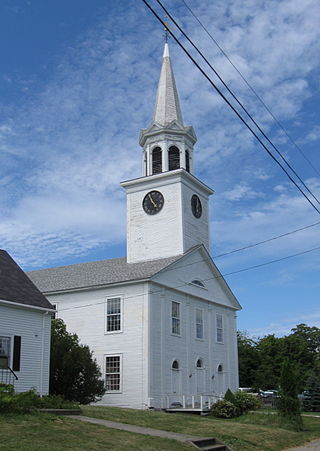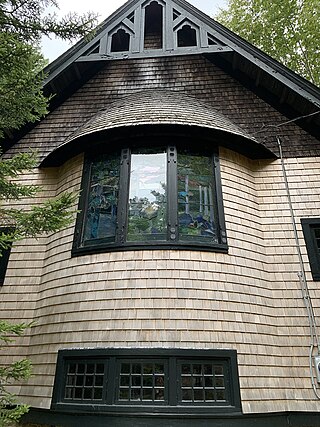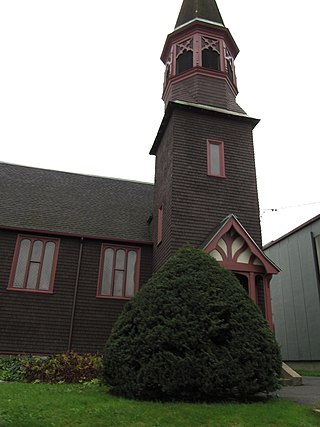
Walker Memorial Hall is a historic community meeting hall on Highland Road in Bridgton, Maine. Built in 1892 to a design by Frederick A. Tompson, it is a well-preserved local example of eclectic Queen Anne architecture, and continues to be a significant community meeting center, hosting social events and meetings of local organizations. It was listed on the National Register of Historic Places in 1983.

St. Anne's Episcopal Church is a historic church at 29 Church Street in Calais, Maine. Built in 1853, it is a locally distinctive example of Carpenter Gothic architecture, and is the only known statewide work of architect James Renwick, Jr. The church building was listed on the National Register of Historic Places in 1982. It is a member of the Episcopal Diocese of Maine; its pastor is the Rev. Sara Gavit.

St. Ann's Episcopal Church is an historic Episcopal church located on Church Street in Richford, Vermont, in the United States. Built in 1883, it is an architecturally a distinctive blend of Queen Anne and Gothic Revival architecture. On March 12, 2001, it was added to the National Register of Historic Places. The church is a defunct mission of the Episcopal Diocese of Vermont; no services are held there.

Trinity Episcopal Church is an historic church building at 247 Bates Street in Lewiston, Maine. It is a modestly sized yet handsomely decorated Gothic Revival building, designed by C.C. Haight of New York City and completed in 1882. The building was listed on the National Register of Historic Places in 1978.

The Former First Congregational Church is a historic church building at 938 Post Road, on the corner of Rt. 1 and Buzzell Road in Wells, Maine. It was built in 1862 on the site of the first colonial meeting house in Wells, believed to have been built in 1664. The building is a fine example of Romanesque and Gothic architecture. It now serves as the museum of the Historical Society of Wells and Ogunquit. The building was listed on the National Register of Historic Places in 1991.

The First Parish Meetinghouse is a historic colonial meeting house at Meeting House Road and Old Pool Road in Biddeford, Maine. Built in 1758, it is the oldest public building in the city, and is one of the oldest buildings of its type in the state. It served as a combined church and town hall until about 1840. It was listed on the National Register of Historic Places in 1972. It is now owned by the Biddeford Historical Society.
The Church of the Advent is a historic church building on Church Street, one block south of the junction with Maine State Route 229 in Limestone, Maine. Built in 1881, the architecturally eclectic Gothic/Romanesque building was constructed for an Episcopalian church congregation founded in 1872, which is believed to be the oldest in Limestone. The church was listed on the National Register of Historic Places in 1991.

The Central Congregational Church is a historic church at 26 Middle Street in Eastport, Maine, USA. The meeting house was built in 1829, and is a remarkably sophisticated example of Federal style architecture for what was then a frontier community. It was listed on the National Register of Historic Places in 1976.

Saint Jude's Episcopal Church is a historic church at 277 Peabody Drive in Seal Harbor, Maine. Built in 1887–89, this Shingle-style church is the least-altered surviving example of ecclesiastical architecture in Maine designed by the noted exponent of the style, William Ralph Emerson. Principally used as a summer chapel, it is affiliated with the Episcopal mission of St. Mary's in Northeast Harbor. The building was listed on the National Register of Historic Places in 1986.

The South China Meeting House, now known as the South China Community Church, is a historic church on Village Street in South China, Maine. Built in 1884 as a Quaker meeting house, it is now home to multi-denominational congregation. It is notable as one of the places that influenced Quaker writer Rufus Jones, who was raised in South China and attended services here after this building replaced the Pond Meeting House. It was listed on the National Register of Historic Places in 1983.

St. Anne's Church and Mission Site is a historic religious site on Down Street at the southern end of Indian Island in Old Town, Maine. The site includes a church, dating to about 1830, and a cemetery, established in 1668. The mission, with a history dating to 1668, is one of the oldest Roman Catholic establishments in New England, and the building is one of the oldest Catholic churches in the region. The site was listed on the National Register of Historic Places in 1973.

St. James Episcopal Church is a historic church at Center and Main Streets in the heart of Old Town, Maine. Built in 1892, the church is one of four works in the state designed by the Gothic Revival specialist Henry Vaughan. It is one of Old Town's few 19th century landmarks, and was listed on the National Register of Historic Places in 1974. Its current minister is the Rev. Jane White-Hassler.

The Former Free Will Baptist Church is a historic church building at 12 High Street in Milo, Maine. It is home to the Milo Historical Society Museum. Built in 1853, this wood-frame structure was Milo's first church, shared initially by Baptist and Free Will Baptist congregations before becoming the exclusive property of the latter. It has served as the local history museum since 1996. The building was listed on the National Register of Historic Places in 2000.

Old Christ Church is a historic Episcopal church at the junction of Vermont Route 12 and Gilead Brook Road in Bethel, Vermont. Built in 1823, it is a well-preserved Federal period church, lacking modern amenities such as electricity and plumbing. The church was added to the National Register of Historic Places in 2008. It is used for services only during the summer.

Methodist Episcopal Church of Butler is a historic former Methodist Episcopal church located at Butler Center in Wayne County, New York. It is a rectangular, gable roofed frame building designed in a vernacular Greek Revival style and built about 1836. It rests on a cobblestone foundation and is surmounted by an open belfry. Also on the property is a cemetery (non-contributing), established in 1864.
Grace Episcopal Church is a historic Episcopal church located at Waverly in Tioga County, New York. It is a Gothic Revival style wood-frame structure, three bays wide and six bays deep, and resting on a brick foundation with cement veneer. The building was built in 1854 and features a steeply pitched gable roof, an arched double door entry, and lancet windows. A wooden belfry is perched on the peak of the gable.

The Grace Memorial Episcopal Church is a historic church in Wabasha, Minnesota, United States, built in 1900. The building was listed on the National Register of Historic Places in 1982 for having local significance in the themes of architecture and religion. It was nominated for being "the most distinguished ecclesiastical structure" in Wabasha and "the work of prominent Minnesota architect Cass Gilbert".

The former Surry Town Hall is located at 1217 Surry Road in the village of Surry, Maine. Built in East Surry in 1848, it served as town hall until 1844, and as a combined church and town hall until about 1881. It was then returned to exclusive municipal use until 1978; it is now home to the Surry Historical Society. It was listed on the National Register of Historic Places in 2008. The town's municipal offices are located in a modern facility on North Bend Road; town meetings are now held in the local school auditorium.

The District No. 2 School is a historic schoolhouse at Pleasant Street and Caribou Road in Passadumkeag, Maine. Built in the 1840s as a school, it later served as a church, town hall, and library. It is now a museum operated by the local historical society, and was listed on the National Register of Historic Places in 1997.
The Union Meeting House is a historic church at 2875 Sennebec Road in Appleton, Maine. Built in 1848, it is a fine local example of Greek Revival architecture. It has served a variety of congregations, and housed the town library for a time. It is now owned by the local historical society. It was listed on the National Register of Historic Places in 2014.



















